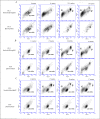Bacterial diversity in the water column of meromictic Lake Cadagno and evidence for seasonal dynamics
- PMID: 30586464
- PMCID: PMC6306205
- DOI: 10.1371/journal.pone.0209743
Bacterial diversity in the water column of meromictic Lake Cadagno and evidence for seasonal dynamics
Abstract
The meromictic Lake Cadagno is characterized by a compact chemocline with high concentrations of anoxygenic phototrophic purple and green sulfur bacteria. However, a complete picture of the bacterial diversity, and in particular of effects of seasonality and compartmentalization is missing. To characterize bacterial communities and elucidate relationships between them and their surrounding environment high-throughput 16S rRNA gene pyrosequencing was conducted. Proteobacteria, Chlorobi, Verrucomicrobia, and Actinobacteria were the dominant groups in Lake Cadagno water column. Moreover, bacterial interaction within the chemocline and between oxic and anoxic lake compartments were investigated through fluorescence in situ hybridization (FISH) and flow cytometry (FCM). The different populations of purple sulfur bacteria (PSB) and green sulfur bacteria (GSB) in the chemocline indicate seasonal dynamics of phototrophic sulfur bacteria composition. Interestingly, an exceptional bloom of a cyanobacteria population in the oxic-anoxic transition zone affected the common spatial distribution of phototrophic sulfur bacteria with consequence on chemocline location and water column stability. Our study suggests that both bacterial interactions between different lake compartments and within the chemocline can be a dynamic process influencing the stratification structure of Lake Cadagno water column.
Conflict of interest statement
We have the following interests. Matthieu Bueche is affiliated to Bueche μlab. There are no patents, products in development or marketed products to declare. This does not alter our adherence to all the PLOS ONE policies on sharing data and materials, as detailed online in the guide for authors.
Figures






Similar articles
-
Dynamic cellular complexity of anoxygenic phototrophic sulfur bacteria in the chemocline of meromictic Lake Cadagno.PLoS One. 2017 Dec 15;12(12):e0189510. doi: 10.1371/journal.pone.0189510. eCollection 2017. PLoS One. 2017. PMID: 29245157 Free PMC article.
-
Long-term population dynamics of phototrophic sulfur bacteria in the chemocline of Lake Cadagno, Switzerland.Appl Environ Microbiol. 2005 Jul;71(7):3544-50. doi: 10.1128/AEM.71.7.3544-3550.2005. Appl Environ Microbiol. 2005. PMID: 16000760 Free PMC article.
-
Succession Processes in the Anoxygenic Phototrophic Bacterial Community in Lake Kislo-Sladkoe (Kandalaksha Bay, White Sea).Mikrobiologiia. 2016 Sep;85(5):531-544. Mikrobiologiia. 2016. PMID: 29364601
-
Molecular Physiology of Anaerobic Phototrophic Purple and Green Sulfur Bacteria.Int J Mol Sci. 2021 Jun 15;22(12):6398. doi: 10.3390/ijms22126398. Int J Mol Sci. 2021. PMID: 34203823 Free PMC article. Review.
-
True marine and halophilic anoxygenic phototrophic bacteria.Arch Microbiol. 2001 Oct;176(4):243-54. doi: 10.1007/s002030100326. Arch Microbiol. 2001. PMID: 11685368 Review.
Cited by
-
Synergistic phenotypic adaptations of motile purple sulphur bacteria Chromatium okenii during lake-to-laboratory domestication.PLoS One. 2024 Oct 22;19(10):e0310265. doi: 10.1371/journal.pone.0310265. eCollection 2024. PLoS One. 2024. PMID: 39436933 Free PMC article.
-
Motile bacteria leverage bioconvection for eco-physiological benefits in a natural aquatic environment.Front Microbiol. 2023 Dec 13;14:1253009. doi: 10.3389/fmicb.2023.1253009. eCollection 2023. Front Microbiol. 2023. PMID: 38163082 Free PMC article.
-
Single-cell genomics-based analysis reveals a vital ecological role of Thiocapsa sp. LSW in the meromictic Lake Shunet, Siberia.Microb Genom. 2021 Dec;7(12):000712. doi: 10.1099/mgen.0.000712. Microb Genom. 2021. PMID: 34860152 Free PMC article.
-
Exploring Viral Diversity in a Gypsum Karst Lake Ecosystem Using Targeted Single-Cell Genomics.Genes (Basel). 2021 Jun 8;12(6):886. doi: 10.3390/genes12060886. Genes (Basel). 2021. PMID: 34201311 Free PMC article.
-
Genomic insights into the coupling of a Chlorella-like microeukaryote and sulfur bacteria in the chemocline of permanently stratified Lake Cadagno.ISME J. 2023 Jun;17(6):903-915. doi: 10.1038/s41396-023-01396-y. Epub 2023 Apr 8. ISME J. 2023. PMID: 37031343 Free PMC article.
References
-
- Finlay BJ, Maberly SC, Cooper JI. Microbial diversity and ecosystem function. Oikos. 1997;80: 209–213. 10.2307/3546587 - DOI
Publication types
MeSH terms
Substances
LinkOut - more resources
Full Text Sources

